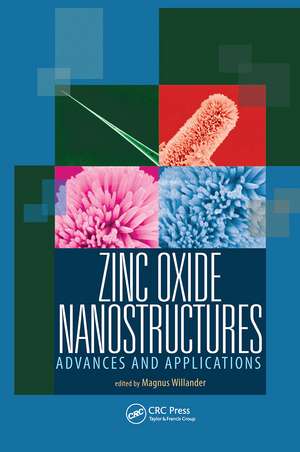Zinc Oxide Nanostructures: Advances and Applications
Editat de Magnus Willanderen Limba Engleză Hardback – 22 iul 2014
Preț: 652.97 lei
Preț vechi: 876.78 lei
-26% Nou
Puncte Express: 979
Preț estimativ în valută:
124.96€ • 135.69$ • 104.97£
124.96€ • 135.69$ • 104.97£
Comandă specială
Livrare economică 02-16 aprilie
Doresc să fiu notificat când acest titlu va fi disponibil:
Se trimite...
Preluare comenzi: 021 569.72.76
Specificații
ISBN-13: 9789814411332
ISBN-10: 9814411337
Pagini: 232
Ilustrații: 101 black & white illustrations, 13 colour illustrations
Dimensiuni: 152 x 229 x 18 mm
Greutate: 0.46 kg
Ediția:New.
Editura: Jenny Stanford Publishing
Colecția Jenny Stanford Publishing
ISBN-10: 9814411337
Pagini: 232
Ilustrații: 101 black & white illustrations, 13 colour illustrations
Dimensiuni: 152 x 229 x 18 mm
Greutate: 0.46 kg
Ediția:New.
Editura: Jenny Stanford Publishing
Colecția Jenny Stanford Publishing
Public țintă
Academic and PostgraduateCuprins
Fabrication of ZnO nanostructures. Optical properties of and optical devices from ZnO-based nanostructures. Piezoelectric Nanogenerator Based on ZnO Nanomaterials. Nanobiology and nano-medical devices using zinc oxide nanostructures. ZnO nanostructures toxicity and phototoxicity characteristics towards biological samples. Zinc oxide nanostructures: Synthesis, characterization and their device applications on non-conventional substrates.
Recenzii
"ZnO is one of the most important piezoelectric and semiconductor materials, which has key applications in electronics, optoelectronics, energy science, and sensors. The newly invented fields of nanogenerators and piezotronics are largely based on ZnO nanostructures. This book covers the basics of ZnO and its potential applications in a range of fields. It can serve a large group of readers who are interested in ZnO nanostructures."
Prof. Zhong Lin Wang, Georgia Institute of Technology, USA
"This book represents a very comprehensive overview of the state of the art in the synthesis, properties, and key emerging applications of one of the most important nanomaterials. With authoritative contributions by recognized world-leading experts, it is destined to become a reference work for students wishing to learn about the subject for the first time or for scientists and engineers already working in the domain who wish to broaden and deepen their understanding."
Dr. David J. Rogers, Nanovation, France
Prof. Zhong Lin Wang, Georgia Institute of Technology, USA
"This book represents a very comprehensive overview of the state of the art in the synthesis, properties, and key emerging applications of one of the most important nanomaterials. With authoritative contributions by recognized world-leading experts, it is destined to become a reference work for students wishing to learn about the subject for the first time or for scientists and engineers already working in the domain who wish to broaden and deepen their understanding."
Dr. David J. Rogers, Nanovation, France
Notă biografică
Magnus Willander is professor in the Department of Science and Technology at Linköping University, Sweden. He received his PhD in physics from the Royal Institute of Technology, Sweden, in 1984. He conducted pioneering research on Si/SiGe, SiC, and polymer devices between 1984 and 1994. Since 2002, Prof. Willander has concentrated on metal oxides and their applications, particularly ZnO nanostructures. He has also studied various III–V materials, carbon-based materials and devices, and fundamental physical problems both theoretically and experimentally. He is a fellow of the American Physical Society and the Institute of Physics (UK).
Descriere
This book deals with one of the most hot nanomaterials today, namely zinc oxide (ZnO) nanomaterials applied to the above areas. In the book are described different methods to grow ZnO nanostructures. Their optical and piezoelectrical properties are described as well as photo-toxicity. Applications to LEDs, lasers, power generators and chemical sensors are discussed. Finally the growth on flexible substrates , particularly ZnO nanostructures and devices on paper substrates are described.
